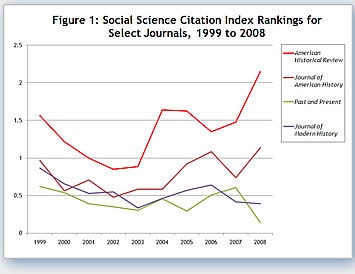The American Historical Review had the highest “impact factor” in its history in 2008, according to the latest Journal Citation Reports from Thomson Reuters.
Put succinctly, the citation reports measure how often articles in a particular journal are cited by peer-reviewed journals in the same discipline. While this is a rather crude gauge of the actual value of recent articles in these journals, it provides one of the few objective measures for testing the overall influence of journals.
By this measure, the AHR has been the top-rated journal in history for more than a decade, ranking well above more specialized journals such as the Journal of American History and the Journal of Modern History (Figure 1).
The impact factor calculates the average number of citations per article in the two years after they were published. So in this case, articles published in the AHR in 2006 and 2007 were cited an average of 2.15 times in 2008. (This represents an increase from an average of 1.47 citations per article in 2007 for articles published in 2005 and 2006.)
Three Review articles garnered four or more citations in 2008: Alison Games’s “Atlantic History: Definitions, Challenges, and Opportunities,” (June 2006) which was cited six times, in the AHR, American Literary History, Early American Literature, History of European Ideas, and the Journal of African History; James Sheehan’s presidential address, The Problem of Sovereignty in European History (January 2006) cited four times, in the AHR, Comparative Studies in Society and History, Differences: A Journal of Feminist Cultural Studies, and Historische Zeitschrift.; and Marcy Norton’s “Tasting Empire: Chocolate and the European Internalization of Mesoamerican Aesthetics” (also from June 2006) also cited four times, in AHR, the History of European Ideas, and Speculum.
As most of you will have surmised, this is a rather flawed way of estimating the actual impact of articles in history journals, which filter out into the journal literature more slowly than in many other disciplines. This was certainly true for the Review, as the 2008 report shows half of the AHR articles cited were more than ten years old.
Even with that as a caveat, the AHR rates quite high relative to other disciplinary journals in the social sciences—with an impact factor higher than the American Anthropologist and American Political Science Review, ranking almost equal to the American Economic Review, and only lagging behind the American Sociological Review.
The AHR’s success is matched by a number of the other journals in the University of Chicago Press portfolio in fields ranging from labor economics to biology, which rank at or near the top of their fields. Sixteen of the thirty-three Press journals rated in the JCR have impact factors in the top ten of their respective categories, with ten journals ranking in the top five, demonstrating that the AHR has joined some very good company at the Press!
This post first appeared on AHA Today.
This work is licensed under a Creative Commons Attribution-NonCommercial-NoDerivatives 4.0 International License. Attribution must provide author name, article title, Perspectives on History, date of publication, and a link to this page. This license applies only to the article, not to text or images used here by permission.
